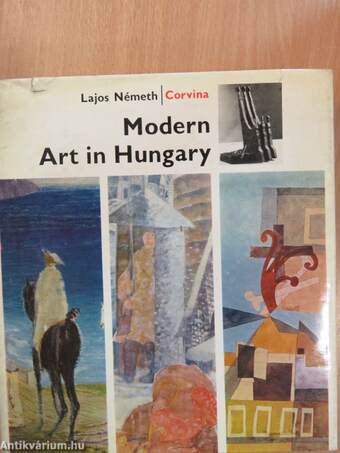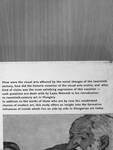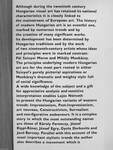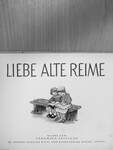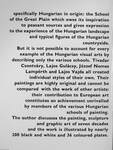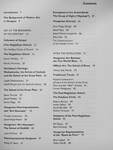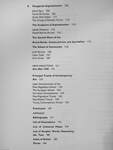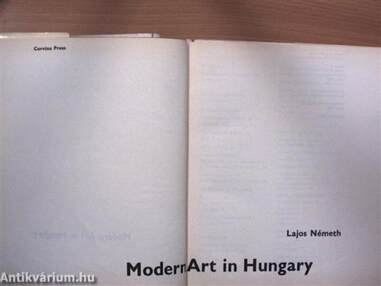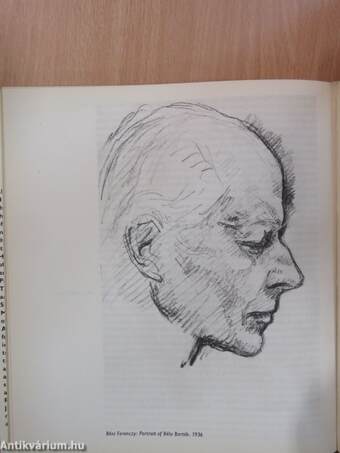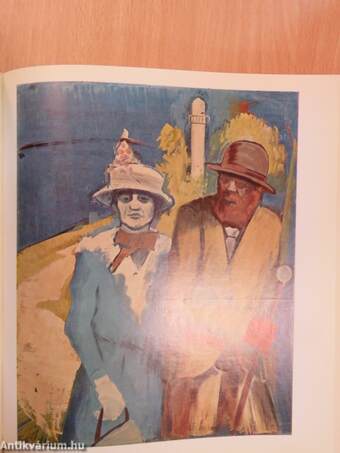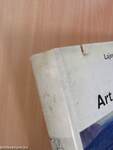1.067.309
kiadvánnyal nyújtjuk Magyarország legnagyobb antikvár könyv-kínálatát

VISSZA
A TETEJÉRE
JAVASLATOKÉszre-
vételek
Modern Art in Hungary
| Kiadó: | Corvina Press |
|---|---|
| Kiadás helye: | |
| Kiadás éve: | |
| Kötés típusa: | Vászon |
| Oldalszám: | 297 oldal |
| Sorozatcím: | |
| Kötetszám: | |
| Nyelv: | Angol |
| Méret: | 24 cm x 22 cm |
| ISBN: | |
| Megjegyzés: | Színes és fekete-fehér fotókkal, reprodukciókkal. |
naponta értesítjük a beérkező friss
kiadványokról
naponta értesítjük a beérkező friss
kiadványokról
Fülszöveg
How were the visual arts affected by the social changes of the twentieth
century, how did the historic vocation of the visual arts evolve, and what
kind of vision was the most satisfying expression of this vocation —
such questions are dealt with by Lajos Németh in his introduction,
to twentieth-century art in Hungary.
In addition to the works of those who are by now the established
classics of modern art, this study offers an insight into the formative
influences of trends which live on side by side in Hungarian art today.
Although during the twentieth century
Hungarian visual art has retained its national
characteristics it is closely linked to
the mainstream of European art. The history
of modern Hungarian art is an eventful one,
marked by numerous trends and by
the creation of many significant works.
Its development has been determined by
Hungarian traditions and by the work
of two nineteenth-century artists whose ideas
and principles were in marked contrast:... Tovább
Fülszöveg
How were the visual arts affected by the social changes of the twentieth
century, how did the historic vocation of the visual arts evolve, and what
kind of vision was the most satisfying expression of this vocation —
such questions are dealt with by Lajos Németh in his introduction,
to twentieth-century art in Hungary.
In addition to the works of those who are by now the established
classics of modern art, this study offers an insight into the formative
influences of trends which live on side by side in Hungarian art today.
Although during the twentieth century
Hungarian visual art has retained its national
characteristics it is closely linked to
the mainstream of European art. The history
of modern Hungarian art is an eventful one,
marked by numerous trends and by
the creation of many significant works.
Its development has been determined by
Hungarian traditions and by the work
of two nineteenth-century artists whose ideas
and principles were in marked contrast:
Pál Szinyei Merse and Mihály Munkácsy.
The principles underlying modern Hungarian
art are for the most part rooted in either
Szinyei's purely pictorial aspirations or
Munkácsy's dramatic and weighty style full
of social significance.
A wide knowledge of the subject and a gift
for appreciative analysis and sensitive
interpretation enables Lajos Németh
to present the Hungarian variants of western
trends: Impressionism, Post-Impressionism,
art nouveau, Constructivism, Surrealism
and non-figurative endeavours. It is a complex
story in which the most outstanding names
are those of Károly Ferenczy, József
Rippl-Rónai, József Egry, Gyula Derkovits and
Jenő Barcsay. Parallel with this account of the
most important stylistic trends the author
also describes a movement which is
BILDER VON
VERONIKA PRITSCHE
DR. HERBERT SCHULZE BUCH- UND KUNSTVE RLAQ NACHF. LEIPZIQ
specifically Hungarian in origin: the School
of the Great Plain which owes its inspiration
to peasant sources and gives expression
to the experience of the Hungarian landscape
and typical figures of the Hungarian
countryside.
But it is not possible to account for every
example of the Hungarian visual arts by
describing only the various schools. Tivadar
Csontváry, Lajos Gulácsy, József Nemes
Lampérth and Lajos Vajda all created
individual styles of their own. Their
paintings are highly original and cannot be
compared with the work of other artists:
their contribution to European art
constitutes an achievement unrivalled
by members of the various Hungarian
schools of painting.
The author discusses the painting, sculpture
and graphic art of seven decades
and the work is illustrated by nearly
200 black and white and 36 coloured plates. Vissza
Témakörök
- Idegennyelv > Idegennyelvű könyvek > Angol > Művészetek > Festészet
- Idegennyelv > Idegennyelvű könyvek > Angol > Művészetek > Művészettörténet, általános
- Idegennyelv > Idegennyelvű könyvek > Angol > Művészetek > Szobrászat
- Művészetek > Művészettörténet általános > Idegen nyelv > Angol
- Művészetek > Művészettörténet általános > Művészettörténet > Magyar
- Művészetek > Művészettörténet általános > Korszakok, stílusok > XIX. század > Impresszionizmus
- Művészetek > Művészettörténet általános > Korszakok, stílusok > XIX. század > Egyéb
- Művészetek > Művészettörténet általános > Korszakok, stílusok > XX. század > Avantgard
- Művészetek > Művészettörténet általános > Korszakok, stílusok > XX. század > Egyéb
- Művészetek > Művészettörténet általános > Összefoglalók > Magyar
- Művészetek > Festészet > Korszakok, stílusok > XIX. század > Impresszionizmus
- Művészetek > Festészet > Korszakok, stílusok > XIX. század > Egyéb
- Művészetek > Festészet > Korszakok, stílusok > XX. század > Avantgárd > Egyéb
- Művészetek > Festészet > Korszakok, stílusok > XX. század > Szecesszió
- Művészetek > Festészet > Korszakok, stílusok > XX. század > Egyéb
- Művészetek > Festészet > Művésztelepek > Egyéb
- Művészetek > Festészet > Idegen nyelv > Angol
- Művészetek > Festészet > Tanulmányok, összefoglalók > Magyar
- Művészetek > Szobrászat > Idegen nyelv > Angol
- Művészetek > Szobrászat > Összefoglalók > Magyar



